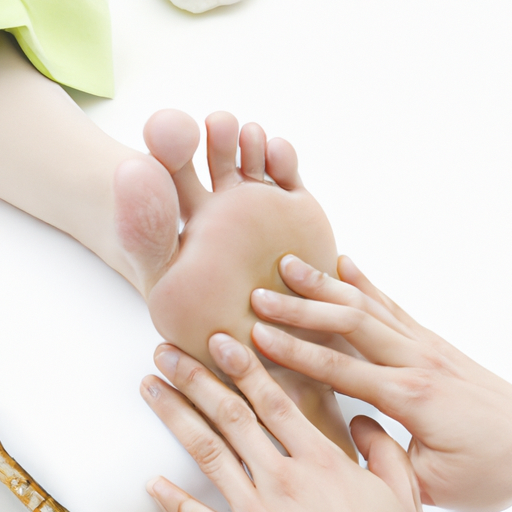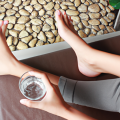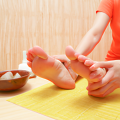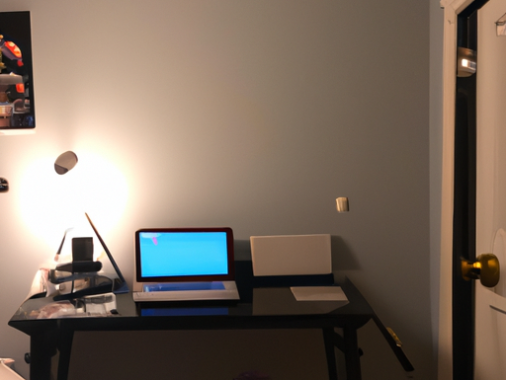-
Table of Contents
- Introduction
- How Can Reflexology Help You Recharge and Rejuvenate?
- What Are the Benefits of Taking a Break After Reflexology?
- How Can Reflexology Help You Relax and Unwind?
- What Are the Benefits of Resting After Reflexology?
- How Can Reflexology Help You Get a Good Night’s Sleep?
- What Are the Benefits of Taking a Nap After Reflexology?
- How Can Reflexology Help You Rebalance Your Energy Levels?
- Q&A
- Conclusion
Introduction
Reflexology is a type of massage therapy that focuses on the feet and hands. It is believed to be a holistic approach to health and wellness, as it is thought to help balance the body’s energy and promote relaxation. Many people wonder if they should rest after reflexology, and the answer is yes. Resting after reflexology can help the body to process the treatment and allow the body to reap the full benefits of the massage. In this article, we will discuss the importance of resting after reflexology and how to do it properly.
How Can Reflexology Help You Recharge and Rejuvenate?
Reflexology is a holistic healing practice that has been used for centuries to promote relaxation, reduce stress, and improve overall health. It is based on the idea that certain areas of the feet, hands, and ears correspond to specific organs and systems in the body. By applying pressure to these areas, reflexology can help to restore balance and promote healing.
Reflexology can help to recharge and rejuvenate the body by reducing stress and tension. When the body is under stress, it can become overwhelmed and unable to function properly. Reflexology helps to reduce stress by stimulating the body’s natural relaxation response. This can help to reduce muscle tension, improve circulation, and promote a sense of calm and wellbeing.
Reflexology can also help to improve energy levels and boost the immune system. By stimulating the body’s natural healing response, reflexology can help to reduce fatigue and improve overall health. It can also help to improve sleep quality, which can help to reduce stress and improve energy levels.
Reflexology can also help to improve mental clarity and focus. By stimulating the body’s natural healing response, reflexology can help to reduce mental fog and improve concentration. This can help to improve productivity and focus, which can help to recharge and rejuvenate the body.
Reflexology can be a great way to recharge and rejuvenate the body. By reducing stress, improving energy levels, and boosting the immune system, reflexology can help to promote relaxation, reduce fatigue, and improve overall health.
What Are the Benefits of Taking a Break After Reflexology?
Taking a break after reflexology can be beneficial for both physical and mental health. Reflexology is a type of massage therapy that focuses on applying pressure to specific points on the feet, hands, and ears. This type of massage can help to reduce stress, improve circulation, and promote relaxation.
The benefits of taking a break after reflexology include improved circulation, reduced stress, and improved mental clarity. Improved circulation helps to reduce inflammation and pain, while also providing more oxygen and nutrients to the body. This can help to improve overall health and well-being.
Reducing stress is another benefit of taking a break after reflexology. Stress can cause physical and mental health issues, such as headaches, fatigue, and depression. Taking a break after reflexology can help to reduce stress levels, allowing the body to relax and heal.
Finally, taking a break after reflexology can help to improve mental clarity. This can help to improve focus and concentration, allowing for better decision-making and problem-solving. It can also help to reduce anxiety and depression, allowing for a more positive outlook on life.
Overall, taking a break after reflexology can be beneficial for both physical and mental health. Improved circulation, reduced stress, and improved mental clarity are just a few of the benefits of taking a break after reflexology. Taking a break after reflexology can help to improve overall health and well-being.
How Can Reflexology Help You Relax and Unwind?
Reflexology is a holistic healing practice that has been used for centuries to promote relaxation and wellbeing. It is based on the principle that certain areas of the feet, hands, and ears correspond to specific organs and systems in the body. By applying pressure to these areas, reflexology can help to reduce stress and tension, improve circulation, and promote relaxation.
Reflexology works by stimulating the body’s natural healing processes. When pressure is applied to the reflex points, it triggers the release of endorphins, which are the body’s natural painkillers. Endorphins also help to reduce stress and anxiety, and promote a sense of wellbeing.
Reflexology can also help to improve circulation, which can help to reduce muscle tension and improve overall health. Improved circulation can also help to reduce fatigue and improve energy levels.
Reflexology can also help to reduce stress and tension by calming the nervous system. This can help to reduce the physical and emotional effects of stress, such as headaches, insomnia, and irritability.
Reflexology can be used as part of a regular relaxation routine. It can be done in the comfort of your own home, or you can visit a reflexologist for a more in-depth session.
Reflexology is a safe and natural way to relax and unwind. It can help to reduce stress and tension, improve circulation, and promote relaxation. It is a great way to take some time out for yourself and to enjoy some much-needed relaxation.
What Are the Benefits of Resting After Reflexology?
Reflexology is a form of alternative medicine that involves applying pressure to specific points on the feet, hands, and ears. This pressure is believed to stimulate the body’s natural healing processes and promote overall wellbeing. Resting after a reflexology session is an important part of the healing process and can provide numerous benefits.
One of the primary benefits of resting after reflexology is that it allows the body to fully absorb the effects of the treatment. During a reflexology session, the practitioner applies pressure to specific points on the feet, hands, and ears. This pressure stimulates the body’s natural healing processes and helps to restore balance and harmony. However, these effects can take time to fully manifest. Resting after a session gives the body time to absorb the effects of the treatment and allows the healing process to take place.
Resting after a reflexology session can also help to reduce stress and tension. Reflexology is known to be a deeply relaxing experience, and resting after a session can help to prolong this feeling of relaxation. This can help to reduce stress and tension in the body, which can have a positive effect on overall wellbeing.
Finally, resting after a reflexology session can help to improve sleep quality. Reflexology is known to be a deeply calming experience, and resting after a session can help to prolong this feeling of relaxation. This can help to improve sleep quality, as the body is more relaxed and better able to drift off into a restful sleep.
In conclusion, resting after a reflexology session is an important part of the healing process and can provide numerous benefits. It allows the body to fully absorb the effects of the treatment, reduces stress and tension, and can help to improve sleep quality.
How Can Reflexology Help You Get a Good Night’s Sleep?
Reflexology is a holistic healing practice that involves applying pressure to specific points on the feet, hands, and ears. It is believed that these points correspond to different areas of the body, and that applying pressure to them can help to reduce stress and promote relaxation. This can be especially beneficial for those who are having difficulty getting a good night’s sleep.
When it comes to improving sleep, reflexology can help in several ways. First, it can help to reduce stress and anxiety, which can be major contributors to insomnia. By applying pressure to the reflex points, the body is able to relax and let go of any tension or worry that may be keeping it awake.
Second, reflexology can help to improve circulation, which can be beneficial for those who suffer from sleep apnea or other breathing problems. By increasing circulation, the body is able to get more oxygen to the brain, which can help to improve sleep quality.
Finally, reflexology can help to reduce pain and inflammation, which can also interfere with sleep. By applying pressure to the reflex points, the body is able to reduce inflammation and pain, allowing for a more restful sleep.
Overall, reflexology can be a great way to improve sleep quality and get a good night’s rest. By reducing stress, improving circulation, and reducing pain and inflammation, reflexology can help to create a more relaxed and restful environment for sleep.
What Are the Benefits of Taking a Nap After Reflexology?
Taking a nap after reflexology can provide a number of benefits. Reflexology is a type of massage therapy that focuses on applying pressure to specific points on the feet, hands, and ears. This type of massage can help to reduce stress, improve circulation, and promote relaxation. Taking a nap after reflexology can help to further enhance these benefits.
One of the primary benefits of taking a nap after reflexology is improved relaxation. During a reflexology session, the body is exposed to a variety of massage techniques that can help to reduce tension and stress. Taking a nap after the session can help to further relax the body and mind, allowing the body to fully absorb the benefits of the massage.
Another benefit of taking a nap after reflexology is improved circulation. During a reflexology session, the massage techniques help to stimulate the circulation of blood and lymphatic fluids throughout the body. Taking a nap after the session can help to further improve circulation, allowing the body to better absorb the nutrients and oxygen it needs.
Finally, taking a nap after reflexology can help to improve overall health and wellbeing. The massage techniques used during a reflexology session can help to reduce stress and tension, while the nap can help to further relax the body and mind. This can help to improve overall mental and physical health, allowing the body to better cope with stress and fatigue.
In conclusion, taking a nap after reflexology can provide a number of benefits. It can help to further relax the body and mind, improve circulation, and improve overall health and wellbeing. For these reasons, taking a nap after reflexology is highly recommended.
How Can Reflexology Help You Rebalance Your Energy Levels?
Reflexology is a holistic healing practice that involves applying pressure to specific points on the feet, hands, and ears. This practice is based on the belief that these points correspond to different areas of the body, and that applying pressure to them can help to restore balance and promote healing.
Reflexology can help to rebalance energy levels by stimulating the body’s natural healing processes. When pressure is applied to the reflex points, it can help to reduce stress and tension, which can lead to improved energy levels. Additionally, reflexology can help to improve circulation, which can help to increase energy levels.
Reflexology can also help to reduce fatigue and improve sleep quality. When the body is well-rested, it can help to improve energy levels. Additionally, reflexology can help to reduce pain and inflammation, which can also help to improve energy levels.
Finally, reflexology can help to improve the body’s overall health and well-being. By stimulating the body’s natural healing processes, reflexology can help to improve the body’s overall functioning, which can lead to improved energy levels.
Overall, reflexology can be a great way to help rebalance energy levels. By stimulating the body’s natural healing processes, reflexology can help to reduce stress and tension, improve circulation, reduce fatigue, and improve overall health and well-being. All of these factors can help to improve energy levels and promote overall health and well-being.
Q&A
1. Is it necessary to rest after reflexology?
Yes, it is important to rest after reflexology. This allows the body to process the effects of the treatment and to restore balance.
2. How long should I rest after reflexology?
It is recommended to rest for at least 30 minutes after a reflexology session.
3. What should I do during my rest period?
During your rest period, it is important to relax and allow your body to process the effects of the treatment. You can do this by taking a nap, reading a book, or listening to calming music.
4. Are there any activities I should avoid after reflexology?
It is best to avoid strenuous activities or activities that require a lot of physical exertion after reflexology.
5. Is it okay to drink alcohol after reflexology?
No, it is not recommended to drink alcohol after reflexology as it can interfere with the body’s ability to process the effects of the treatment.
6. Is it okay to take a shower after reflexology?
Yes, it is okay to take a shower after reflexology. However, it is important to avoid hot water as this can be too stimulating for the body.
7. Is it okay to exercise after reflexology?
It is best to wait at least 24 hours after reflexology before engaging in any strenuous physical activity.
Conclusion
In conclusion, reflexology can be a great way to relax and reduce stress, and it is important to rest after a reflexology session. Resting after reflexology can help the body to process the effects of the treatment and can help to ensure that the benefits of the treatment are maximized. Therefore, it is recommended that you take some time to rest after a reflexology session.




